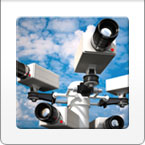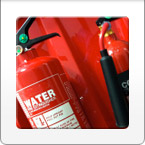Rapid Deployment CCTV
It goes without saying that the main advantage is you can move from a site with little or no electronic security, to a fully remotely monitored CCTV system with audio annunciation and intruder detection in a matter of a couple of hours.
This is where the NAS (Network Accessible Surveillance) rapidly deployable CCTV system really shines, because it truly is a rapidly deployable system.
Most (if not all) the deployable systems available today require some wiring when on site. They might need a cable running from the detector to the camera or from the controls to a speaker to facilitate the audio. Either way, this is time and expense that the NAS does not require.
The NAS’s battery operated detectors can be mounted up to 500m away from the NAS. The batteries are good for between 18 months and 2 years and they require absolutely no cable whatsoever. The signals are all sent via the inbuilt radio transmitter to the NAS upon receipt of which, the NAS will automatically pan, tilt and zoom to that pre-programmed location. Can you imagine the costs of the civil engineering and labour required to run a 500m cable?
Then there’s the audio. The NAS’s audio system is built in so there is no need for supplementary power supplies, waterproof boxes and cabling to get it operational.
The fitting of the NAS could not be easier as you simply nut and bolt the quick-release bracket to a WEC pole clampor a 360VisionTechnology corner mount , or simply bolt it to a flat wall. The NAS then slips over the bracket and locks on with a padlock. Simply apply the mains electricity and 90 seconds later the NAS is fully live and ready to go.
The programming of the NAS has been designed to be as quick and efficient as possible. Once the NAS is live you simply WiFi to it from your laptop in the comfort of your car. You then pan, tilt and zoom to the required detector view and press ‘set preset 1’. Do this for each of the 8 wireless detectors and you are finished. If you know where the NAS will be monitored, just let us know the details and we will pre-program it for you before it leaves the factory.
That’s it. The next time an intruder is detected the NAS will detect them, record them, transmit them to a remote monitoring centre and a 24/7 operator will audibly challenge them. Most audibly challenged intruders either identify themselves as legitimate visitors or run away.
Because the NAS detects intruders BEFORE they enter a building there is generally no damage, so there is no loss of business, there is no insurance claim and therefore no insurance premium hike. Often the most expensive claim on a break-in is the damage the intruder causes breaking in, not the asset that he actually steals. With the NAS this expensive problem becomes highly unlikely.
By definition the NAS is Network Accessible, this allows persons other than the remote monitoring centre to access it. The mobile guard or keyholder would be able to log into the NAS remotely from a laptop, iPad, iPhone, Blackberry, Smartphone etc. and actually check the site prior to leaving the safety of their vehicle.
Then there’s the building manager. Why drive to site when you can connect from your computer and look around it without moving from your desk? Check the skip has been emptied, the windows are clean or if the grass needs cutting. You could even check the arrival and departure times of your contractors to ensure the billing is correct as you would have full access to the NAS’s 1Tb, month long archive.
But does the NAS have to be a temporary deployment? No! An installer fitted a NAS to a water utility that was being hit by thieves and vandals on average once per week. This was in June 2010. The NAS is still in situ and there has not been a single recorded crime since its deployment. And why haven’t the site owners fitted a permanent security system? Because it would be considerably more expensive than the NAS. I have already mentioned that the NAS communicates to everything wirelessly but a permanent system would require extensive civil engineering to get the cables to the right places. The water authority did the intelligent thing, they purchased more NAS units and deployed them and left this one where it was effective.
Below is a basic schematic showing how a typical NAS deployable CCTV system would look on site: You might only need one unit, so ignore the other three:
You are now probably wondering what the drawbacks are, cost maybe? The honest answer is there are non. The cost is far from prohibitive, hence the water authorities decision to leave it in place. Even the requirement for mains electricity has been overcome with the use of our optional Hydrogen Fuel Cell Generator. We can literally deploy the NAS in the middle of a field.
The Fuel Cell is not as expensive as you might imagine and, at the time of writing, B.O.C. (the British Oxygen Company) would deliver 4 ‘K’ cylinders of Hydrogen to site and take away the empties for about £180. These cylinders will power the NAS for up to a month. The generator is almost silent and emits water vapour as its exhaust, so we can even deploy inside buildings as the emissions are not harmful.
The NAS has a vast array of detection devices in its arsenal. Whilst the Battery operated, wireless PIR has become the norm, it also works with wireless beams, wireless tilt sensors and wireless door contacts. In fact we can wirelessly monitor almost anything that gives a changing state output when in alarm.
The NAS has some good credentials when it comes to self preservation. The original units were made from Kevlar reinforced composite material, but this was very expensive. After much analysis from Warwick University Technology Department we came up with an alternative at a fraction of the cost but with very similar vandal resistant properties.
The NAS V2 units are made from Rotary Moulded Polyethylene. It’s invisible to radio so all the antenna are protected but it is incredibly strong. We accidentally tested it one windy day when the temporary demonstration tripod the NAS was placed on blew over in a high wind. The NAS fell from 8 feet to the ground and not only continued to function fully but didn’t even exhibit any sign the incident had ever happened.
The NAS also has an uninterruptible Power Supply (UPS) built in. This UPS seamlessly powers the NAS in the event of a power failure and it also connects to the remote monitoring centre to alert them that the site, or the NAS, could be under attack. The operator can then track the GPS coordinates of the NAS by using Google Earth which is normally accurate to approximately 10 feet.
The week point of most vandal resistant cameras is the window through which the camera looks. The industry standard for a dome camera is 3mm but the NAS enjoys 5mm of Polypropylene and the above-mentioned incident didn’t even leave a mark.
So, if your looking for a cost effective, quickly deployed, self preserving CCTV system that can be remotely monitored and accessed by authorized persons using almost any media device then look no further than the NAS.
Did I mention that it can see in total darkness for in excess of 80 metres thanks to its twin LED arrays that track with the pan and tilt of the camera? Or that various options exist for the NASv2 such as a ruggedised PTZ version or a dual output Thermal Imaging version? For further details please see our promo video at http://thebloomfieldgroup.co.uk/rds-home or our on-line brochure at http://www.thebloomfieldgroup.co.uk/brochure/index.html email us at sales@thebloomfieldgroup.co.uk or simply call on 0844 984 9645.
Latest News
-
Family Business of The Year
- Jan 25, 2022 -
New Plexus Member: VWS
- Jan 25, 2022 -
New Plexus Member: TIS LTD
- Jan 25, 2022 -
New Plexus Member: Quadrant Security Group
- Jul 17, 2020 -
New Plexus Member
- Jan 01, 2019










